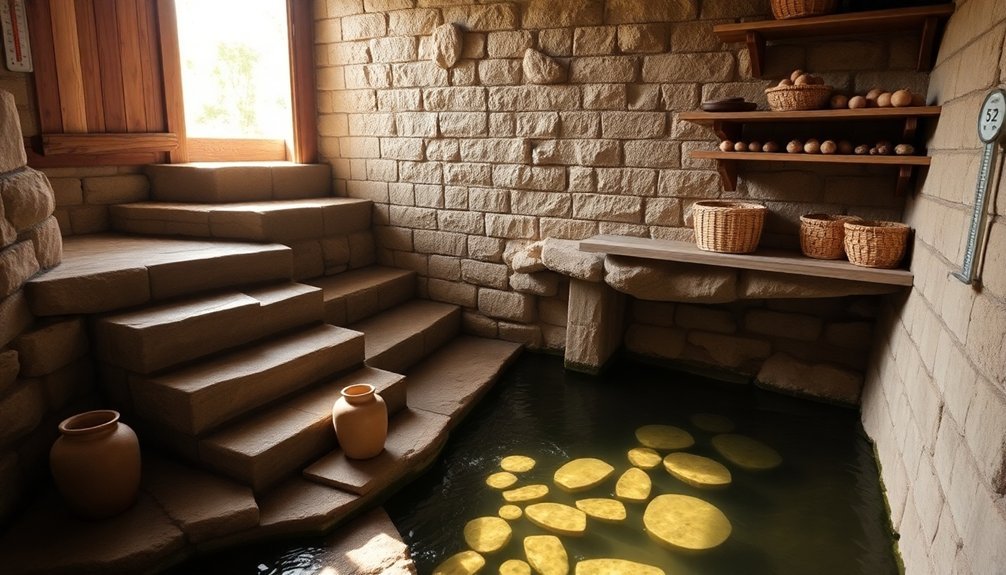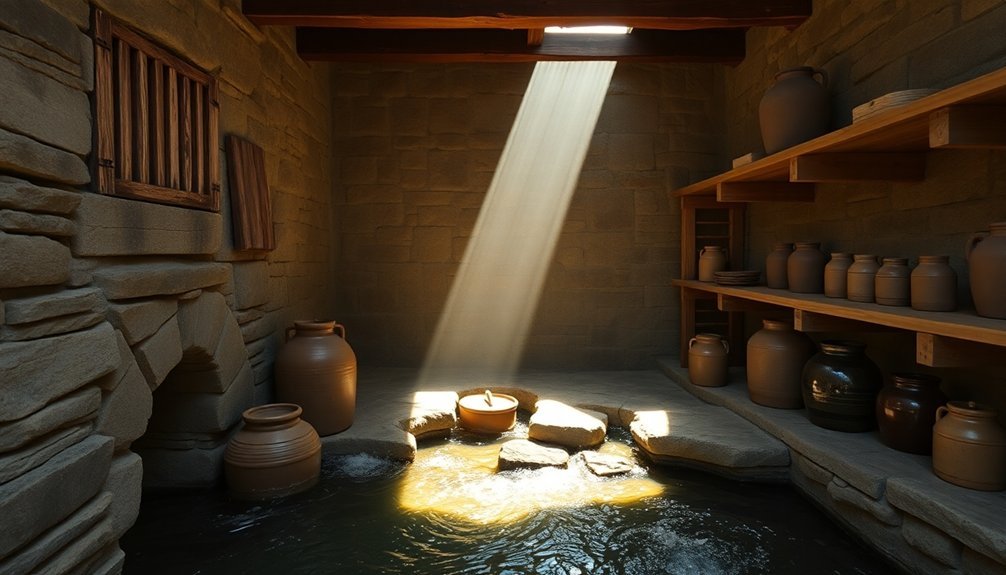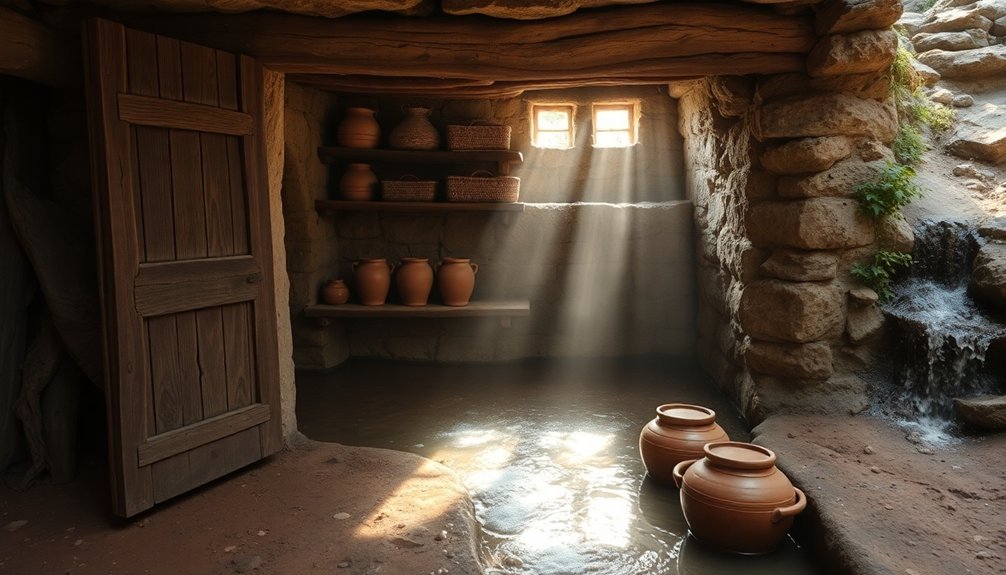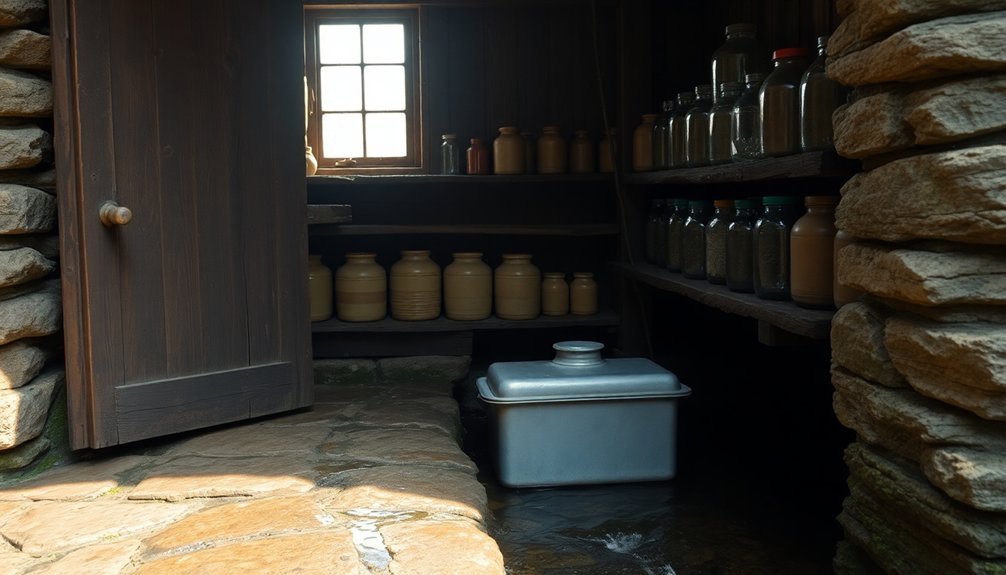You'll reveal the timeless power of spring houses by understanding five key secrets that kept food fresh for generations. First, locate your spring house where natural groundwater emerges, ideally near limestone for natural filtration. Next, harness evaporative cooling through clay pot systems to drop temperatures up to 40%. Then, position strategic ventilation points to maintain consistent airflow and prevent moisture buildup. Create distinct temperature zones ranging from 32°F to 70°F for different food types. Finally, manage humidity levels between 50-60% using natural dehumidification techniques. These time-tested methods hold even more preservation potential than you might imagine.
Optimal Underground Location Selection

A successful spring house begins with selecting the perfect underground location, where natural springs meet ideal geological conditions.
You'll want to identify a natural spring where groundwater emerges from underground, particularly in areas where the ground slope intersects with the water table. Look for limestone veins nearby, as they naturally filter and enhance the water's quality.
Choose a spot where the slope is steeper than the water table to guarantee proper water flow, and verify that the groundwater maintains a consistent temperature of around 50 degrees Fahrenheit throughout the year. The year-round cooling effect made spring houses essential for preserving perishable foods in the 1800s.
You'll need stable ground conditions to prevent structural issues, and good drainage is essential to avoid water accumulation around your spring house.
For practical purposes, select a location that's easily accessible from your main house while still maintaining enough elevation difference for natural water flow.
Prioritize naturally shaded areas to help regulate temperature. Before finalizing your site selection, test the water quality to confirm it's free from contamination, as this will directly impact your food storage capabilities and drinking water safety.
Natural Water Cooling Systems
Natural cooling systems in spring houses rely on the ingenious principle of evaporative cooling through a nested clay pot design. You'll find this system consists of two clay pots: a larger outer pot and a smaller inner one, with wet sand filling the space between them.
When you add a wet cloth on top, you've created a remarkably effective cooling system that can reduce internal temperatures by up to 40% compared to the outside air. This 100% ecological solution uses only natural materials like water and sand for cooling.
You'll need to position your cooling system in a shady, well-ventilated area where dry air can flow freely around it. The system works best when humidity stays below 40% and daily temperatures exceed 25°C.
You'll have to add water one to three times daily to maintain cooling efficiency, though you can use non-potable water if you've properly separated the layers.
Your stored produce will benefit considerably from this cooling method. You can extend the shelf life of fruits, vegetables, and leafy greens up to ten times longer than usual.
Leafy greens that typically last one day can remain fresh for over four days, while staying protected from sunlight, heat, dirt, and pests.
Strategic Ventilation Placement

Strategic placement of ventilation systems forms the backbone of effective food preservation in spring houses.
You'll want to position air curtains at entryways to create an invisible barrier that keeps warm, moist air out while maintaining the cool, dry environment inside. These curtains also prevent unwanted dust and insects from entering your storage space.
Install end wall exhaust fans near the ceiling where hot air naturally accumulates. They'll work to eliminate temperature stratification and guarantee consistent cooling throughout your spring house. Maintaining temperature between 10-15°C is crucial for preventing food spoilage.
You'll find this particularly effective in maintaining uniform conditions from floor to ceiling, which is vital for food preservation.
Position centrifugal fans strategically to create thorough air circulation patterns. You'll need to place them so they can effectively mix the air, preventing stagnant pockets where moisture might accumulate.
These fans should work in conjunction with your fresh air intake systems to reduce ethylene gas buildup and regulate humidity.
To maintain ideal moisture levels below 15%, confirm your ventilation components work together as a system.
You'll achieve this by creating a continuous airflow pattern that moves from intake points, through your storage areas, and out through exhaust points.
Temperature-Controlled Storage Zones
Inside every well-designed spring house, maintaining distinct temperature-controlled storage zones is essential for food preservation. You'll need to establish different areas that match specific temperature requirements for various food types, much like nature's own refrigerator.
Create your primary cold storage zone by positioning items closest to the water source, where temperatures typically stay between 32°F and 40°F. This area's perfect for your dairy products, meats, and leafy vegetables that need protection from the danger zone (40°F-140°F). You'll want to keep these items elevated on stone or wooden platforms to prevent direct contact with standing water.
Set up your secondary zone slightly farther from the cooling source, where temperatures hover between 50°F and 70°F. This space works well for your root vegetables, canned goods, and dried foods that don't require intense cooling. You can use shelving units or hanging baskets to maximize this area's efficiency.
Remember to monitor these zones regularly with a thermometer, as temperature consistency is vital. If you notice any zone climbing above its target range, you'll need to adjust your ventilation or consider repositioning your stored items.
Humidity Management Techniques

Managing humidity levels in your spring house requires three essential components: proper monitoring, active control measures, and smart storage practices.
You'll need a reliable hygrometer to track humidity levels, keeping them between 50% and 60% for most foods. When levels climb above 70%, you're at risk for mold and bacterial growth.
To maintain control, you'll want to invest in dehumidifiers for areas that tend to get too damp. If you're processing foods, enclosed belt coaters and spray dryers can help manage moisture content effectively.
For storage, use airtight containers to lock in ideal humidity levels and prevent unwanted moisture absorption.
Don't forget to implement proper storage strategies for different food types. You'll want to keep potatoes, onions, and garlic in dark, ventilated spaces, while using breathable produce bags for fruits and vegetables.
Place paper towels in storage containers to absorb excess moisture, and separate ethylene-producing fruits from sensitive produce.
If you notice signs of clumping or moisture buildup in your storage systems, that's your cue to adjust humidity levels promptly.
Frequently Asked Questions
How Do You Prevent Small Animals From Entering the Spring House?
You'll need to seal entry points with caulk and mesh, inspect walls for gaps, maintain a clean yard without debris, eliminate food sources, and verify no animals are trapped before permanent sealing.
Can Electrical Backup Cooling Systems Be Installed in Traditional Spring Houses?
While you could install electrical backup cooling systems in a spring house, it's not recommended. You'll face challenges with moisture, electrical infrastructure, and historical preservation. Plus, it'll compromise the structure's traditional natural cooling design.
What Types of Shelving Materials Are Best for Spring House Storage?
You'll want to use polymer or aluminum shelving in your spring house, as they're resistant to moisture and easy to clean. Stainless steel works too, but it's pricier and heavier to install.
How Often Should Spring House Water Sources Be Tested for Contamination?
You'll need to test your spring water annually for bacteria, nitrates, and nitrites. Check every 3-5 years for other contaminants like arsenic and lead. After heavy rains, conduct additional tests to guarantee safety.
Does Storing Different Fruits Together Affect Their Individual Shelf Lives?
Yes, storing fruits together can considerably affect their shelf life. You'll want to keep ethylene-producing fruits like apples and bananas separate from other produce, as they'll speed up ripening and potential spoilage.
In Summary
You'll discover that implementing these five spring house techniques transforms how you store and preserve food. By selecting the right underground spot, utilizing natural water cooling, placing ventilation strategically, creating temperature zones, and managing humidity levels, you're tapping into time-tested methods that work without electricity. Give these solutions a try, and you'll enjoy fresher food while reducing your environmental impact and utility costs.





Leave a Reply